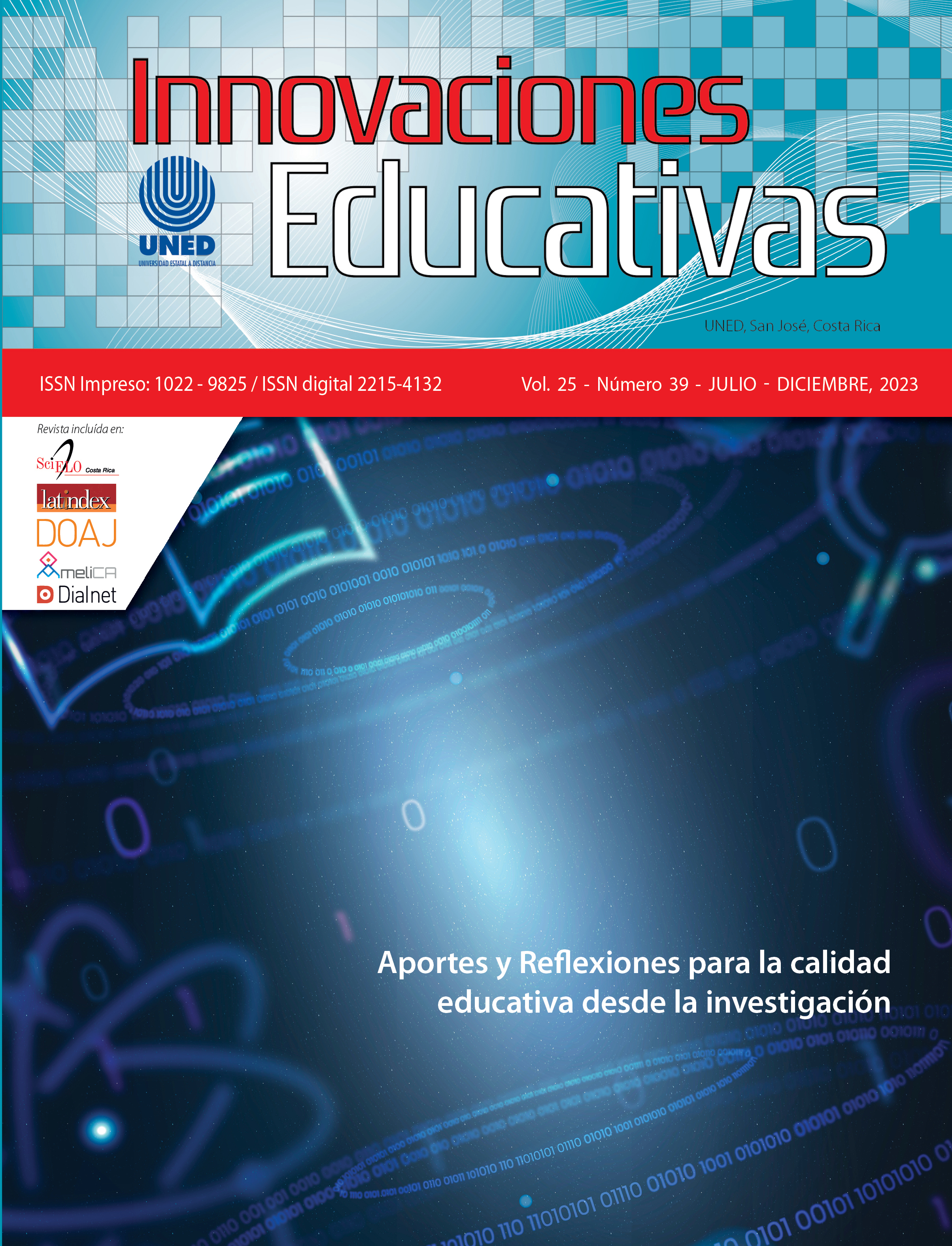Planet Plant Multimedia: Technological educational resources for learning and teaching Botany in a distance education environment
DOI:
https://doi.org/10.22458/ie.v25i39.4602Keywords:
Botany, distance education, educational resources, information technology, educational technologyAbstract
This systematization is related to the development of the multimedia "Planeta Planta" (in Spanish), a proposal that is part of the management of technological resources for distance teaching and learning of the General Botany course of the Natural Resources Management career of the Universidad Estatal a Distancia (UNED), Costa Rica. The first stage of the project included a diagnosis of the factors that affected student performance in the General Botany course in 2017. Based on the results of the diagnosis, the multimedia “Planeta Planta” was created, based on a constructivist paradigm and a cognitivist epistemological approach to promote meaningful learning. Multimedia is characterized by containing a variety of training activities, concept maps, images of plant anatomical structures, conceptual diagrams, and videos on plant physiological processes, among other resources. The validation of the product was carried out with students and teaching experts. Both groups considered that “Planeta Planta” is an educational resource with great usability and that it can increase motivation towards learning botany.
References
Ausubel, D. (1976). Psicología educativa. Un punto de vista cognoscitivo. Editorial Trillas.
Bjurström, A., Rasmussen, N. y Schreil, E. (2014). Barriers and enablers to organizational integration in cross-border mergers & acquisitions. http://lup.lub.lu.se/student-papers/record/4294731
Bada, S. O. y Olusegun, S. (2015). Constructivism learning theory: A paradigm for teaching and learning. Journal of Research & Method in Education, 5(6), 66-70. https://iosrjournals.org/iosr-jrme/papers/Vol-5%20Issue-6/Version-1/I05616670.pdf
Cabero-Almenara, J. y Valencia-Ortiz, R. (2021). Reflexionando sobre la investigación educativa en TIC. Revista Innovaciones Educativas, 23, 7-11. https://revistas.uned.ac.cr/index.php/innovaciones/
article/view/3761
Çengel, M. y Kocaman, O. (2015). Investigation of the factors that affect the success and satisfaction of the students in distance education: Sample of Sakarya University. Turkish Online Journal of Educational Technology, publicación especial, 282-291. https://files.eric.ed.gov/fulltext/ED585217.pdf
Díaz-Barriga, F. (2003). Cognición situada y estrategias para el aprendizaje significativo. Revista Electrónica de Investigación Educativa, 5(2), 105-117. https://www.redalyc.org/articulo.oa?id=15550207
Flores, J., Caballero, M. y Moreira, M. (2013). Una interpretación de la teoría del aprendizaje significativo de Ausubel en el contexto del laboratorio didáctico de ciencias. Aprendizagem Significativa em Revista/Meaningful Learning Review, 3(3), 41-54. https://www.if.ufrgs.br/asr/artigos/
Artigo_ID77/v3_n3_a2013.pdf
Hallyburton, C. y Lunsford, E. (2013). Challenges and opportunities for learning biology in distance-based settings. Bioscene, 39(1), 27-33. https://files.eric.ed.gov/fulltext/EJ1020526.pdf
Hernández, R., Fernández, C. y Baptista, P. (2014). Metodología de la investigación (6.a ed.). McGraw-Hill/Interamericana Editores.
Jäkel, L. (2013). Interest and learning in plant biodiversity, as influenced by teaching contexts. En E-Book Proceedings of the ESERA 2013 Conference: Science Education Research for Evidence-based Teaching and Coherence in Learning (pp. 1-12). European Science Education Research Association. https://www.ph-heidelberg.de/fileadmin/ms-institute/institut-ngt/dokumente/Interest_in_plant
_biodiversity2013.pdf
Marquès, P. (2000). Tipos de página web aplicables en educación. http://peremarques.net/disdesaw.htm
Mendoza, A. (2017). Los saberes de la era digital: Aprendizaje, nuevas tecnologías y artes expresivas (Estudio teórico y aplicación práctica) [Tesis inédita doctoral en Metodologías humanísticas en la era digital]. Universidad de Alicante. https://rua.ua.es/dspace/bitstream/10045/85888/1/tesis_
alejandro_silvestre_mendoza.pdf
Mora, F. (2017). Bimodalidad, ¿necesidad u obligación para una educación a distancia democratizadora y accessible? El caso de la UNED de Costa Rica. Revista Ensayos Pedagógicos, 12(2), 145-167. https://doi.org/10.15359/rep.12-2.7
Novak, J., Ring, D. y Tamir, P. (1971). Interpretation of research findings in terms of Ausubel’s theory and implications for science education. Information Visualization Journal, 5(3), 175-184.
Novak, J. y Cañas, A. (2006). La teoría subyacente a los mapas conceptuales y a cómo construirlos. Reporte Técnico IHMC CMapTools 2006-01. https://cmapspublic.ihmc.us/rid=1229115907587_
_17144/TeoriaSubyacenteMapasConceptuales.pdf
Pozo, J. y Gómez, M. (2010). Por qué los alumnos no comprenden la ciencia que aprenden. Qué podemos hacer nosotros para evitarlo. Alambique: Didáctica de las ciencias experimentales, (66), 73-79. https://iespoman-cat.infd.edu.ar/sitio/upload/Por_que_los_alumnos_no_comprenden_Pozo.pdf
Preciado, F., Arcega, A. y Pedraza, O. (2014). Propuesta de un simulador de negocios para estudiantes de facultades económico-administrativas. Tecnología Educativa Revista CONAIC, primer número especial-Congreso ANIEl 2014, 60-70. https://doi.org/10.32671/terc.v1i2.183
Prokop, P. y Fančovičová, J. (2014). Seing coloured fruits: Utilisation of the theory of adaptive memory in teaching botany. Journal of biological education, 48(3), 127-132. https://doi.org/10.1080/00219266.2013.837407
Ramdass, D. y Zimmerman, B. (2011). Developing self-regulation skills: The important role of homework. Journal of Advanced Academics, 22(2), 194-218. https://doi.org/10.1177/1932202X1102200202
Sánchez, E. (2015). Deserción estudiantil en la UNED: Seguimiento de una cohorte de estudiantes de primer ingreso. Revista Electrónica Calidad En La Educación Superior, 6(1), 289-324. https://doi.org/10.22458/caes.v6i1.878
Santos da Silva, J., Guimaraes, F. y Takeo, P. (2016). Teaching of Botany in higher education: representations and discussions of undergraduate students. Revista Electrónica de Enseñanza de las Ciencias, 15(3), 380-393. https://repositorium.sdum.uminho.pt/bitstream/1822/44500/1/REEC_15_3_4_ex1044.pdf
Schunk, D. (2012). Learning theories: An educational perspective (6.a ed.). Allyn & Bacon.
Schwendimann, B. (2015). Concept maps as versatile tools to integrate complex ideas: From kindergarten to higher and professional education. Knowledge Management & E-Learning, 7(1), 73-99. https://bit.ly/Schwendimann
Stagg, B. y Donkin, M. (2013). Teaching botanical identification to adults: Experiences of the UK participatory science project ‘Open Air Laboratories’. Journal of Biological Education, 47(2), 104-110. https://doi.org/10.1080/00219266.2013.764341
Tirado, F. (2015). Entornos educativos: Educación en contextos. Revista Virtual Redipe, 4(7), 6-15. https://revista.redipe.org/index.php/1/article/view/368
Universidad Estatal a Distancia. (2005). Modelo pedagógico. Vicerrectoría Académica. https://www.uned.ac.cr/academica/images/igesca/materiales/24.pdf
Universidad Estatal a Distancia. (2018a). Manejo de Recursos Naturales. Escuela Ciencias Exactas y Naturales. https://www.uned.ac.cr/ecen/carrera/manejo-de-recursos-naturales/inicio
Universidad Estatal a Distancia. (2018b). Orientaciones académicas: Botánica General (Teoría). Código: 00856. Vicerrectoría Académica. http://orientacionesacademicas.uned.ac.cr/documentos/2018400856.pdf
Uno, G. E. (2009). Botanical literacy: What and how should students learn about plants? American Journal of Botany, 96(10), 1753-1759. https://doi.org/10.3732/ajb.0900025
Zambrano, D. y Gómez, J. (2017). Actividades prácticas que propician el aprendizaje del concepto de microbiología en el aula. Revista Bio-grafía. Escritos sobre la Biología y su enseñanza, 957-965. https://doi.org/10.957.10.17227/bio-grafia.extra2017-7261
Zepeda, H. y Méndez, M. E. (2016). Aplicaciones multimedia para el fortalecimiento de competencias laborales. Revista Iberoamericana de Contaduría, Economía y Administración, 5(10), 1-16. https://doi.org/10.23913/ricea.v5i10.85
Downloads
Published
How to Cite
Issue
Section
License
Copyright (c) 2023 Innovaciones Educativas

This work is licensed under a Creative Commons Attribution-NonCommercial-NoDerivatives 4.0 International License.

